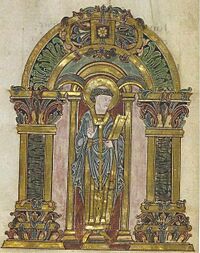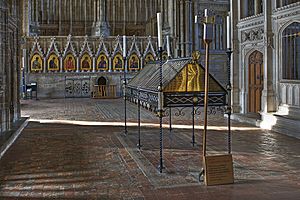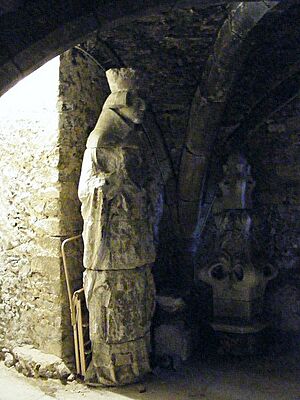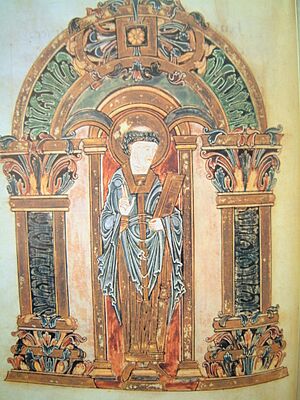Swithun facts for kids
Quick facts for kids SaintSwithun |
|
|---|---|

Portrait of St Swithun in the Benedictional of St Æthelwold, c. 970s
|
|
| Bishop of Winchester | |
| Born | c. 800 possibly Hampshire |
| Died | 2 July 863 Winchester, Hampshire |
| Venerated in | Roman Catholic Church Anglican Communion Eastern Orthodox Church |
| Major shrine | Winchester Cathedral. Parts survive in cathedral museum. Also modern replacement shrine. |
| Feast | 2 July (Norway) 15 July (England) |
| Attributes | Bishop, holding a bridge, broken eggs at his feet |
| Patronage | Hampshire; Winchester; Southwark; the weather |
Swithun (also spelled Swithin) was an important Anglo-Saxon bishop who lived a long time ago. He was the bishop of Winchester, a city in England, from 852 until he died in 863.
Even though he was a real person, Swithun is mostly famous for the amazing stories and miracles linked to him after his death. Many people know him because of a popular saying about the weather. It says that if it rains on his special day, July 15th, it will keep raining for the next forty days!
Contents
Who Was Swithun?
Swithun became the Bishop of Winchester on October 30, 852. He served in this important role until he passed away on July 2, 863. Not much was written about him during his own lifetime. However, his death was recorded in an old book called the Anglo-Saxon Chronicle.
About a hundred years later, church leaders named Dunstan and Æthelwold of Winchester were making big changes to the church. They chose Swithun as the special saint for the main church in Winchester. This church used to be dedicated to St. Peter and St. Paul.
On July 15, 971, Swithun's body was moved from its old grave to Æthelwold's new church. People at the time said that many miracles happened before and after his body was moved.
Stories and Legends
Because Swithun became so famous, many stories and legends were written about him. One old book of saint stories, written around the year 1000, doesn't have many facts about his life. Most of what we think we know about Swithun comes from a later book written in the 11th century.
According to these stories, Saint Swithun was born when Egbert of Wessex was king. He became a priest and was known for his wisdom. The king heard about him and asked Swithun to teach his son, Æthelwulf of Wessex. Swithun became one of the king's closest friends.
Later, under King Æthelwulf, Swithun became the Bishop of Winchester. He was known for being very religious and for working hard to build new churches or fix old ones. He even convinced the king to give a tenth of his royal lands to the Church. Swithun liked to travel around his area on foot. When he held big dinners, he invited poor people instead of rich ones.
One of Swithun's most famous miracles happened on a bridge. Some workers had meanly broken a basket of eggs belonging to a woman. Swithun, with his special powers, made the eggs whole again! Another famous story tells of Queen Emma's ordeal, but that story appeared much later. Swithun died on July 2, 862. He asked to be buried outside the north wall of his church. He wanted people to walk over his grave and for raindrops to fall on it from the roof.
Honoring Saint Swithun

In England, Saint Swithun's special day is July 15th. In Norway, it's July 2nd. His body was moved from his outdoor grave to a special indoor shrine in the old church at Winchester in 971. Later, parts of his body were likely split up and placed in smaller shrines. For example, his head was taken to Canterbury Cathedral.
His main shrine was moved again in 1093 to the new, bigger Winchester Cathedral. It was placed on a special platform behind the main altar. A new part of the church was built in the 1200s. This was to make room for all the pilgrims who wanted to visit his shrine. They would even crawl through a "holy hole" underneath it.
Swithun's shrine in Winchester was believed to be a place where many miracles happened in the Middle Ages. The head of the monks, Æthelwold, said that every time a miracle happened, all the monks had to stop what they were doing and go to the church to praise God. There's a story that the monks got tired of this because they sometimes had to go to the church three or four times a night! They decided to stop going. But then, Saint Swithun appeared in a dream and warned them that if they stopped, the miracles would stop too. So, the monks decided to go back to the church every time a miracle happened.
The Church of England still remembers Saint Swithun with a special day on July 15th.
What He's Known For
Swithun is seen as one of the saints people pray to if there is a drought. A drought is a long period of very dry weather.
Places Named After Him
Many churches are named after Saint Swithun, especially in the south of England. For example, St Swithun's Church, Headbourne Worthy is surrounded by a small stream. Its entrance gate is also a bridge over the stream, which is quite unusual!
Other places named after him include churches in Walcot, Lincoln, and Worcester. In western Norway, the main church in Stavanger is also dedicated to him. There's even a street in London called St Swithin's Lane. St Swithun's School, Winchester for girls in Winchester and a part of Magdalen College, Oxford are also named after him.
The Weather Proverb

Saint Swithun's name is most famous today because of a British weather saying. It goes like this:
St. Swithun's day if thou dost rain
For forty days it will remain
St. Swithun's day if thou be fair
For forty days 'twill rain nae mare
This means that if it rains on July 15th (St. Swithun's Day), it will rain for the next forty days. But if it's sunny, then the next forty days will be mostly dry.
Swithun had asked to be buried outside the church. He wanted his grave to be walked over by people and to be rained on. This suggests that the idea of rain being connected to him was already known a long time ago.
When his body was moved indoors in 971, some people later said that a heavy rainstorm happened that day. They thought it was Swithun showing he was unhappy about being moved. However, older writings from the 10th century say that the move happened just as the saint wanted.
Some people think the proverb might come from older traditions about predicting the weather. In other countries, different saints have similar weather sayings around the same time of year. For example, in France, St. Medard (June 8) is linked to the weather.
There's also a scientific reason why this proverb might sometimes seem true. Around the middle of July, the jet stream often settles into a pattern that stays fairly steady until the end of August. The jet stream is a fast-moving air current high in the atmosphere. If it's north of the British Isles, warm, dry air from Europe can move in. If it's over or south of the British Isles, then colder, wetter weather from the Atlantic is more likely.
See also
- Saint Swithun in popular culture


